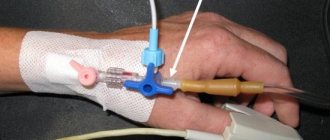What is endotracheal anesthesia?
Endotracheal anesthesia is one of the types of anesthesia that uses endotracheal intubation; alternative name: general anesthesia. The term anesthesia comes from the Greek and means “without feeling.”
During anesthesia, the entire body or individual parts of the body are not felt. Competent medical professionals - anesthesiologists - use the term "tube anesthesia" to refer to general anesthesia. If only certain parts of the body are numbed, it is called local anesthesia.
Endotracheal anesthesia - contraindications
Endotracheal anesthesia cannot be used for everyone. There are serious contraindications that cannot be ignored:
Infectious diseases.- Problems with the endocrine glands.
- Kidney and liver diseases.
- Diseases of the lungs and bronchi.
- Respiratory diseases.
- Severe endocrine diseases.
- Unusual structure of the pharynx.
If there are contraindications, another method of anesthesia will be considered. An examination must be carried out; perhaps you do not yet suspect any diseases.
Anesthesia is contraindicated for acute manifestations of these diseases. The anesthesiologist should learn about them before surgery during a consultation.
Otherwise, it is better to refuse surgery and insist on fulfilling the preoperative requirements. It is also important that the anesthesiologist warns the patient about the type of anesthesia that will be used.
Indications for use
Anesthesia with a tube in the throat makes many medical interventions possible, because “switching off” the sensation of pain is a prerequisite for many diagnostic and therapeutic procedures. Thanks to significant advances in medicine, modern anesthesia is safe, gentle and can be administered based on individual risks.
Depending on the type of procedure, as well as the constitution and medical history of the patient, today it is possible to accurately dose the necessary medications. After major surgery and intensive care, anesthesia also plays an important role in the treatment of acute pain.
An anesthesiologist always accompanies the patient during surgery in the clinic or operating center. He works across all disciplines and age groups of patients. That is, regardless of whether a colonoscopy is performed on a 55-year-old, a caesarean section on a 30-year-old, or an arm removal on a 5-year-old. The anesthesiologist helps prevent the patient from waking up and correctly induces anesthesia.
§1. What is endotracheal anesthesia: features of the procedure
It is difficult to imagine that some time ago the word operation was associated with the word death. In those days, people on the operating table died from painful shock or blood poisoning.
For a long time, humanity has been moving toward the discovery of the concept of anesthesia. Thanks to the development of chemistry, this became possible. Nowadays, surgical intervention is sometimes a necessary procedure for the patient to continue living a full life.
This is a chance for health that cannot be obtained using only medication.
Endotracheal anesthesia. A little history
An irreplaceable discovery that protects the human body from stress and allows not only the patient to comfortably undergo surgery, but also enables surgeons to do their job.
Anesthesia is the main element of any serious surgical intervention - lungs, nervous system, esophagus, heart. It is characterized by a complete loss of consciousness.
General endotracheal anesthesia is different in that it can be used for patients of any age. It consists of inserting a special thin tube into the trachea, connected to a device, through which narcotic substances are injected.
That's why it has this name: endo - inside and trachea. It is also called intubation or combined, because the drugs enter both the blood and the respiratory tract.
The world of medicine became acquainted with endotracheal anesthesia back in the 14th-15th centuries, thanks to the Swiss Paracelsus. It was this doctor who first used the method of inserting a tube into a person’s trachea, which saved him from death.
Andrei Vesalius continued his path, proving that this particular anesthesia should become the main anesthesia. When conducting experiments on animals, the indispensability of endotracheal anesthesia was undeniable.
In the 17th and 18th centuries, thousands of drowned people on the Thames were saved by the English doctor Cologne, thanks to a special tube inserted into the trachea.
Further more. A German doctor showed that if you use a tube with a cuff, you can prevent the most dangerous complication of that time - the presence of foreign substances in the respiratory canals during endotracheal anesthesia.
The next stage in the field of anesthesia was recorded in 1942, when the Canadian doctor Griffith and his partner Johnson used muscle relaxants. It was truly a breakthrough in medicine. Muscle relaxants relaxed the muscles and prevented the patient from moving. Moreover, they made it possible to control and manage anesthesia.
The 50s began with the rapid conquest of endotracheal anesthesia and its widespread use, with the enormous contribution of Soviet doctors - Vishnevsky, Kupriany and others.
Carrying out endotracheal anesthesia
Indications
Endotracheal anesthesia is sometimes called complex due to the use of several narcotic substances introduced gradually into the patient's body. This allows it to be used for long operations that require more than 30 minutes. The muscles are relaxed at this time, consciousness is turned off, which allows the surgeons to do their job.
Indications for the use of endotracheal anesthesia:
- the need to use muscle relaxants during surgery;
- fears of airway obstruction;
- unstable nervous system;
- "full stomach" syndrome;
- long and extensive dental interventions;
- long-term operation using microsurgical equipment;
- operations in the oral cavity, head, pharynx, inner ear;
- laparoscopy.
How is endotracheal anesthesia performed?
Before undergoing general anesthesia, the patient must undergo an examination. Next, preparation for surgical sleep or premedication begins. If the operation is planned, then in the evening the patient is relaxed and calmed with the help of barbiturates.
An antihistamine is also prescribed and tranquilizers are selected. On the operating table, the patient is given atropine before the operation to exclude a situation of cardiac arrest and analgesics.
Anesthesia is carried out in three stages
- Introduction. The most important stage. Before inserting the tube into the patient's trachea, the patient is disconnected. Any anesthesia that puts a person into anesthetized sleep is used. This is what allows you to insert a special tube that artificially ventilates the lungs. If an error occurs at this stage, for example, the tube is inserted incorrectly, then complications will arise during the operation.
- Support. It is used in the first and second stages of anesthesia. Combination drugs are administered. To prevent surgical injuries, anesthetic agents are used. And to relax muscles - relaxants.
- Excretion. Anesthesia is administered by gradually reducing the dose of narcotic drugs and relaxants. When the mark reaches 0, then consciousness wakes up, and tone and the ability to independently ventilate the lungs return to the muscles. Then extrusion occurs - removal of the tube from the trachea.
Administration of anesthesia
There are several ways:
- intravenously with a gradual infusion of anesthesia. A combination of analgesics and anesthetics, seasoned with oxygen and nitrogen, is used;
- using inhalation using oxygen, nitrogen, narcotic, analgesic and anesthetic drugs.
Before the operation, anesthesiologists must check the effect of narcotic substances on the human body and decide which drug to use during surgery.
Initial anesthesia is usually light. His goal is intubation. If this is an inhalation method, then a mixture of nitrogen and oxygen or the preparations “Etrana”, “Ftorotana”, “Forana” and similar anesthetics are often used. If administered intravenously, it will most likely be a barbiturate with droperidol or fentanyl.
The dose is selected individually, taking into account body weight and body characteristics. Droperidrol typically lasts about 5 hours. But the effect of fentanyl lasts only 20 minutes and requires repeated administration. Half an hour before the end of the operation, its supply stops.
In order to insert the tube, you will need to relax your neck muscles. Muscle relaxants should already act here. After intubation, the patient is connected to mechanical ventilation and the deep sleep stage begins.
Support
This is a period of active work for surgeons. Anesthesia is monitored every 15 minutes throughout the operation. Blood pressure and pulse are observed. If a patient has cardiovascular problems, cardiac activity must be monitored.
All parameters are indicated by the nurse in a special anesthesia record. It also prescribes all the actions of the doctors, indicating the time, the dose of administered narcotic substances, and relaxants used during the operation. These records are then pasted into the patient’s medical history.
Exit from deep sleep occurs with a gradual reduction in the dosage of administered drugs. To restore breathing, atropine and proserine are administered one after another.
Advantages
It is not for nothing that this anesthesia is the most popular; a number of reasons contribute to this:
- Patency of the respiratory canals, regardless of the patient’s position.
- Use of a small dose of narcotic drugs.
- Use of muscle relaxants.
- The possibility of surgical intervention on the heart, which was previously impossible.
- Less exposure to toxic drugs.
- Easy awakening after endotracheal anesthesia.
- Minimal effect on the kidneys and liver.
- No risk of breathing or cardiac complications.
Complications after endotracheal anesthesia
We have already mentioned that if the tube is inserted incorrectly, complications arise. They can appear during or after surgery.
Often, in the presence of cardiovascular diseases, improper use of drugs is accompanied by loss of large amounts of blood and tracheal intubation.
After the operation, troubles may occur in the form of the following complications:
- muscle pain;
- sore throat after using the tube;
- cough after endotracheal anesthesia;
- lung infection;
- allergic reactions;
- nausea;
- loss of consciousness;
- disorders in the nervous system;
- brain damage;
- laryngospasm;
- itching;
- shiver;
- injuries to teeth, tongue, throat.
Usually these manifestations disappear within 2 days. There is no need to blame the doctor for all complications; the individual characteristics of the patient’s body and his susceptibility to medications play a big role here.
Due to the large number of complications when using the tube, the laryngeal mask appeared in 1981. It is not inserted into the trachea, but is located at the entrance to the larynx. Thanks to the cuff on the mask, a tight seal is created. This is a completely safe invention that eliminates the occurrence of laryngospasm after surgery.
But, despite such advantages, the use of a mask is not always successful and appropriate, not to mention the high cost. It happens that due to a leak in the mask between the larynx and esophagus, asphyxia occurs. And besides, it cannot be used in emergency cases due to the problem of a “full stomach”.
Endotracheal anesthesia - contraindications
Endotracheal anesthesia cannot be used for everyone. There are serious contraindications that cannot be ignored:
- Infectious diseases.
- Problems with the endocrine glands.
- Kidney and liver diseases.
- Diseases of the lungs and bronchi.
- Respiratory diseases.
- Severe endocrine diseases.
- Unusual structure of the pharynx.
If there are contraindications, another method of anesthesia will be considered. An examination must be carried out; perhaps you do not yet suspect any diseases.
Anesthesia is contraindicated for acute manifestations of these diseases. The anesthesiologist should learn about them before surgery during a consultation.
Otherwise, it is better to refuse surgery and insist on fulfilling the preoperative requirements. It is also important that the anesthesiologist warns the patient about the type of anesthesia that will be used.
Preparation
In a preliminary discussion with the anesthesiologist, the patient receives an information sheet with instructions on what to consider before the procedure. Rules of conduct are intended for your own safety:
- You should not eat or drink sugary drinks 6 hours before your scheduled surgery.
- 2 hours before anesthesia it is forbidden to drink even clean water.
- Smoking is prohibited on the day of surgery.
- If medications are taken on a regular basis, it is necessary to discuss anesthesia with the anesthesiologist beforehand.
- Blood thinners (eg, new oral anticoagulants, acetylsalicylic acid) in higher doses should not be taken before surgery. Exception: acetylsalicylic acid in a dosage of 100 mg.
- The use of coatings, cream or nail polish is prohibited.
- It is necessary to remove any jewelry (necklaces, piercings, rings, earrings) even on those parts of the body that will not undergo surgery.
- Contact lenses should not be worn in the operating room or examination room.
- It is important to remove loose dentures or wigs early.
Smoking is prohibited on the day of anesthesia.
During outpatient procedures, it is recommended to leave keys and valuables (wallets, smartphones) at home. If necessary, you can ask the nurses where you should place your personal items during the procedure.
Premedication
Before any operation or medical procedure in which the sensation of pain in a larger area of the body will be “turned off,” a preliminary conversation with an anesthesiologist is held. This conversation is also called premedication. A brief conversation helps the anesthesiologist decide which form of anesthesia (general or regional) is most appropriate for the patient for the planned procedure.
Patients should bring the following documentation with them to the doctor's office:
- documents related to the upcoming procedure (laboratory data, x-rays, medical reports);
- insurance policy;
- treatment plan.
The dose and composition of the anesthetic depend on the nature of the procedure and individual factors. In addition to the patient's age, weight, and gender, general health and existing allergies play an important role in anesthesia planning. Since regular use of drugs or psychotropic substances (eg, nicotine, alcohol) can significantly affect the effect of anesthetics, the patient should answer the anesthesiologist's questions honestly.
In some cases, consultation with other specialists and further tests (eg, blood tests, chest x-rays, or ECGs) are necessary to evaluate the optimal method of anesthesia.
As part of the preliminary discussion, the anesthesiologist will explain not only the benefits, but also the possible risks of the chosen anesthesia method. If necessary, the specialist will provide the patient with an information sheet for the upcoming procedure.
The patient confirms the accuracy of the anesthetic information provided with his signature. Of course, the patient can revoke this consent verbally at any time.
Stages of implementation and their features
General anesthesia induces a controlled sleep-like state in which awareness and pain are eliminated throughout the body. This ensures that the patient does not notice the operation, does not move or experience pain during the entire procedure.
Medicines before surgery
Shortly before surgery, the patient is often given a tranquilizer or anxiolytic in the hospital and given saline to regulate fluid balance. For general anesthesia, the specialist usually uses a combination of drugs that is tailored to the patient's individual needs.
The drug combination consists of a sleeping pill, painkillers (analgesics) and partly a muscle relaxant. In adults, the anesthetic is administered intravenously through a venous access (often on the back of the arm). In children, inhalation anesthesia is more often used. The action of the anesthetic begins in both cases immediately after administration.
Progress of the operation
Modern general anesthesia is “gentle” and can be adjusted individually. Side effects are rare. The anesthesiologist will talk about this in a preliminary conversation. For very short procedures, the patient may be ventilated through a face mask. If it is a longer or larger operation, the patient is ventilated with a tube (tracheal) through the windpipe (intubation) or throat (laryngeal mask). The tube or laryngeal mask is inserted while the patient is already in deep sleep.
The anesthesiologist accompanies the entire procedure and monitors the patient’s physical functions (cardiac activity, heart rate, reflexes). At the same time, he checks the depth of anesthesia and can adjust it if necessary. If the procedure takes longer than expected, the anesthesiologist will dose the anesthetic through the veins or tube. This way, patients don't have to worry about waking up during surgery.
Awakening
When the procedure is completed, delivery of the anesthetic is interrupted and the patient wakes up after a few minutes. Often, however, the patient cannot remember the phase of the surgical intervention. The gradual return of consciousness after anesthesia is usually accompanied by trained personnel in a special recovery room.
After waking up, the patient must remain in the hospital for 24 hours
If pain occurs when the anesthesia wears off, the person receives pain medication. In some cases, the patient will already be given analgesics through a catheter during surgery. If the values of the still monitored organ functions are normal and stable, he can return to his room. In the case of an outpatient procedure, the patient undergoes a final medical examination, after which he can go home.
The patient must remain in the hospital for 24 hours after anesthesia and not participate in traffic. The patient usually receives advice on behavior after leaving the hospital, for example regarding taking medications and further visits to the doctor.
Carrying out endotracheal anesthesia
Indications
Endotracheal anesthesia is sometimes called complex due to the use of several narcotic substances introduced gradually into the patient's body. This allows it to be used for long operations that require more than 30 minutes. The muscles are relaxed at this time, consciousness is turned off, which allows the surgeons to do their job.
Indications for the use of endotracheal anesthesia:
- the need to use muscle relaxants during surgery;
- fears of airway obstruction;
- unstable nervous system;
- "full stomach" syndrome;
- long and extensive dental interventions;
- long-term operation using microsurgical equipment;
- operations in the oral cavity, head, pharynx, inner ear;
- laparoscopy.
How is endotracheal anesthesia performed?
Before undergoing general anesthesia, the patient must undergo an examination. Next, preparation for surgical sleep or premedication begins. If the operation is planned, then in the evening the patient is relaxed and calmed with the help of barbiturates.
An antihistamine is also prescribed and tranquilizers are selected. On the operating table, the patient is given atropine before the operation to exclude a situation of cardiac arrest and analgesics.
Anesthesia is carried out in three stages
. The most important stage. Before inserting the tube into the patient's trachea, the patient is disconnected. Any anesthesia that puts a person into anesthetized sleep is used. This is what allows you to insert a special tube that artificially ventilates the lungs. If an error occurs at this stage, for example, the tube is inserted incorrectly, then complications will arise during the operation.
Introduction- Support . It is used in the first and second stages of anesthesia. Combination drugs are administered. To prevent surgical injuries, anesthetic agents are used. And to relax muscles - relaxants.
- Removal . Anesthesia is administered by gradually reducing the dose of narcotic drugs and relaxants. When the mark reaches 0, then consciousness wakes up, and tone and the ability to independently ventilate the lungs return to the muscles. Then extrusion occurs - removal of the tube from the trachea.
Administration of anesthesia
There are several ways:
- intravenously with a gradual infusion of anesthesia. A combination of analgesics and anesthetics, seasoned with oxygen and nitrogen, is used;
- using inhalation using oxygen, nitrogen, narcotic, analgesic and anesthetic drugs.
Before the operation, anesthesiologists must check the effect of narcotic substances on the human body and decide which drug to use during surgery.
Initial anesthesia is usually light. His goal is intubation. If this is an inhalation method, then a mixture of nitrogen and oxygen or the preparations “Etrana”, “Ftorotana”, “Forana” and similar anesthetics are often used. If administered intravenously, it will most likely be a barbiturate with droperidol or fentanyl.
The dose is selected individually, taking into account body weight and body characteristics. Droperidrol typically lasts about 5 hours. But the effect of fentanyl lasts only 20 minutes and requires repeated administration. Half an hour before the end of the operation, its supply stops.
In order to insert the tube, you will need to relax your neck muscles. Muscle relaxants should already act here. After intubation, the patient is connected to mechanical ventilation and the deep sleep stage begins.
Support
This is a period of active work for surgeons. Anesthesia is monitored every 15 minutes throughout the operation. Blood pressure and pulse are observed. If a patient has cardiovascular problems, cardiac activity must be monitored.
All parameters are indicated by the nurse in a special anesthesia record. It also prescribes all the actions of the doctors, indicating the time, the dose of administered narcotic substances, and relaxants used during the operation. These records are then pasted into the patient’s medical history.
Exit from deep sleep occurs with a gradual reduction in the dosage of administered drugs. To restore breathing, atropine and proserine are administered one after another.
Advantages
It is not for nothing that this anesthesia is the most popular; a number of reasons contribute to this:
- Patency of the respiratory canals, regardless of the patient’s position.
- Use of a small dose of narcotic drugs.
- Use of muscle relaxants.
- The possibility of surgical intervention on the heart, which was previously impossible.
- Less exposure to toxic drugs.
- Easy awakening after endotracheal anesthesia.
- Minimal effect on the kidneys and liver.
- No risk of breathing or cardiac complications.
Possible complications
Problems with the delivery of anesthesia and the patient's pre-existing medical conditions must be taken into account when assessing complications during surgery. A clear distinction between these factors is not always possible. The mortality rate of the sum of these factors is defined as “perioperative mortality.” Complication rates and mortality from surgery vary greatly. The reasons are the lack of uniform definitions, different population groups and observation periods.
The risk of complications increases with age. Currently, from 0.001 to 0.014% (1-14/100,000 anesthesia) cases are recorded annually.
The imputed slight increase in complication rates in recent years is due to a disproportionate increase in surgical procedures in very old patients.
Post-anesthesia respiratory distress, cardiovascular complications, medication confusion, and errors in preoperative assessment and patient preparation are leading causes of mortality. Sometimes patients experience respiratory arrest during anesthesia (apnea). Most of the other complications are potentially preventable.
Consequences of endotracheal anesthesia
A dangerous complication is improper intubation of the esophagus, which, if not detected in time, is fatal. Instead of the lungs, the stomach is ventilated, so the patient suffocates. Currently, inappropriate intubation only occurs outside of routine monitoring. If the doctor recognizes incorrect intubation, he should correct it immediately.
Failed intubation becomes a complication, especially if the patient cannot be ventilated otherwise. After unsuccessful intubation attempts, the respiratory system may become blocked due to swelling and bleeding. Therefore, for routine intubations (eg during anesthesia), there is always a plan for managing a difficult airway. Terrible complications include vocal cord dysfunction and aspiration pneumonia.
If the tube is advanced too far, only one lung may be ventilated. In this case, the right main bronchus is usually intubated well, while the left one is poorly intubated. However, this problem can be easily seen by auscultation, that is, listening with a stethoscope and retracting the tube one or two centimeters.
Advantages and disadvantages of modern endotracheal anesthesia
To accurately understand that intubation anesthesia is a reliable method of inducing a patient into narcotic sleep, let’s consider its main advantages compared to mask sleep.
- Recession of the tongue and epiglottis is excluded. The tube is inserted in such a way as to prevent negative consequences and possible emergency situations during the operation, including respiratory failure or arrest.
- The exact dosage of the narcotic mixture allows you to eliminate its excessive entry into the patient’s body.
- Anesthetic drugs are supplied under pressure
- Foreign masses (mucus from the bronchi, pus, blood) are automatically eliminated and do not enter the tube, thanks to a special device for endotracheal anesthesia.
But nothing is ideal, and therefore the method of endotracheal anesthesia has its drawbacks.
- Difficulty in intubation (the doctor must be an experienced professional).
- There is a risk of injury to the mucous membranes of the respiratory tract.
Contraindications
Relative contraindications to anesthesia:
- hormone-dependent tumors or diseases;
- decompensated diseases of internal organs;
- heart rhythm disturbances of various etiologies;
- alcohol or drug intoxication;
- post-infarction period.
Heart rhythm disturbances of various etiologies are a contraindication to endotracheal anesthesia.
There are no absolute contraindications, since sometimes the benefits of the procedure significantly outweigh the potential risks. Before anesthesia, you should consult with your doctor.
Possible consequences
- Nausea, vomiting, intestinal obstruction due to intestinal paresis.
- Aspiration of vomit (difficulty breathing, cyanosis of the skin, tachycardia, pulmonary edema, pneumonia).
- Soreness, pain, dryness and discomfort in the throat.
- Regurgitation of stomach contents into the oral cavity.
- Allergic manifestations, anaphylactic shock.
- Damage to the root of the tongue, epiglottis, larynx, vocal cords, trachea during insertion of an endotracheal tube. Fracture of teeth, lower jaw.
- Insertion of a tube into the right bronchus or esophagus, which leads to hypoxia and cardiac arrest.
- Laryngospasm or closure of the true vocal cords . In this case, muscle relaxants that relax skeletal muscles are helpful.
- Bronchial spasm . In this situation, bronchodilators (aminophylline) are used, since muscle relaxants do not act on smooth muscles.
- A drop in blood pressure, resulting in shock and kidney failure.
- Breathing disorders: asphyxia.
- The endotracheal tube is bent and falls out.
- From the heart and blood vessels : disturbances in heart rhythm and conduction, acute heart failure, increased blood pressure.
- From the nervous system : psychosis, headache, dizziness, weakness. Possible: delusions, hallucinations, paresis, sensitivity disorders, mood swings.
Specifics of endotracheal anesthesia in children
In children, when preparing for procedures under anesthesia, different recommendations apply than in adults. Features that should be taken into account during anesthesia in a child include, for example, breathing, cardiovascular regulation, functions of immature organs and body temperature.
If a child needs surgery, it is always a stressful situation. Not only for the sick child, but for the whole family. However, parents should always know that the procedure helps their baby recover. The decision to undergo surgery is never taken lightly. This is only considered because the child has a condition that is not otherwise treatable or because surgery is the best available treatment option for the child.
It was previously thought that surgery in children was associated with an increased risk of complications. In 2020, a meta-analysis conducted by French scientists did not reveal a negative effect of anesthesia on children under 3 years of age.











